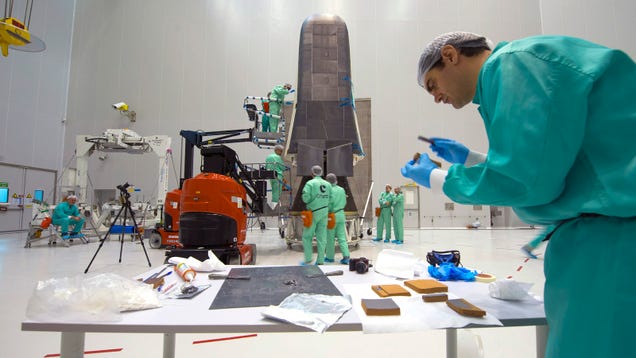
This is the European Space Agency's test spaceplane, which is planned to go on a 100 minute mission without a crew on February 11. It will blast off from Kourou, French Guiana.
What you're seeing is actually the belly of the so called Intermediate eXperimental Vehicle (IXV), more precisely the two body flaps and the heat shield of the wingless spaceplane, which was created in order to test reentry technologies for future European space vehicles.
IXV will be launched into a suborbital trajectory up to 420 km and it will return to Earth at a speed of 7.5 km/s at an altitude of 120 km just as those vehicles returning from a low-orbit mission. The demonstrator spacecraft, very similar to the lifting bodies NASA experimented on the way to substantiate the space shuttle technology, is 5 m long, 1.5 m high, and 2.2 m wide, and fully packed with conventional and advanced sensors, recording tons of data during the fiery atmospheric dive. IXV will glide through the atmosphere at hypersonic and supersonic speeds before the main parachute deploys to slow the descent for a safe splashdown in the Pacific Ocean.
The IXV comprises state of the art thermal protective shells made of ceramics and ablatives, carbon-fibre reinforced polymer structural panels to hold inner elements in place during launch and landing, and certain functional and experimental subsystems, such as power, data handling, telemetry, multi stage supersonic parachute, floatation devices, and actuators. Definitely no place for an astronaut in this sleek car sized object.

The Intermediate eXperimental Vehicle (IXV) flight model during integration at Thales Alenia Space, Torino, Italy, on 12 February 2014.

The IXV during the last preparations at Thales Alenia Space, Torino, Italy.



The IXV installed on its payload adapter, being prepared for launch, at Europe's Spaceport in Kourou.

On 23 June 2014 a prototype of the IXV was recovered off the coast of Tuscany, Italy in a practice run. If everything goes according to the plans these balloons will keep the IXV afloat.

The Nos Aries recovery vessel is stationed in Flamenco Island Anchorage in Panama. Over the last month, the crew have been testing the equipment for hoisting IXV out of the water.

These flaps are going to provide thermal protection and control pitch and roll during the long glide back through the atmosphere. Space shuttles had two elevons and one body flap for the same function:

All photos by ESA, except the last one by Bill Ingalls/NASA.
from ffffff http://gizmodo.com/this-european-spaceplane-may-spawn-the-next-space-shutt-1682304017
via IFTTT







0 comentarios:
Publicar un comentario